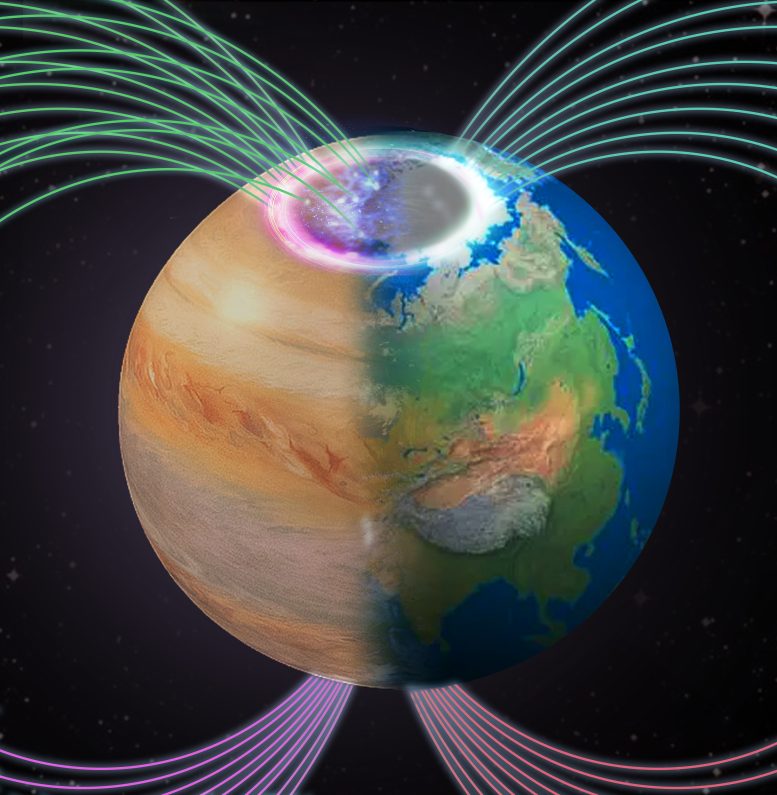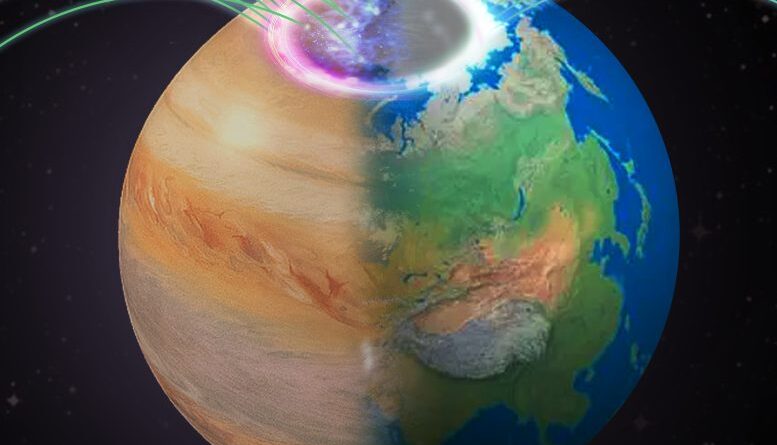Sky Shows: Physicists Identify Cosmic Dance of Auroras on Earth, Jupiter, and Saturn.

Conceptual image showing the contrasting aurora between Earth and Jupiter. Credit: Professor Zhonghua Yao, University of Hong Kong
A recent study reveals new information about aurorae across the Earth, Jupiterand Saturnwhich highlights the role of gravity and the solar wind in shaping these phenomena, which has major implications for space weather forecasting and planetary exploration.
The spectacular aurorae, commonly known as the Northern and Southern Lights, have captured people’s attention for centuries. From May 10 to 12, 2024, the strongest aurora event in 21 years showed the extraordinary beauty of these celestial lights.
Recently, atmospheric physicists from the Department of Earth Sciences at the University of Hong Kong (HKU), including Professor Binzheng Zhang, Professor Zhonghua Yao, and Dr Junjie Chen, along with their international colleagues, published the paper The Nature of Astronomy which explores the fundamental laws governing the different types of aurorae seen across the planets, such as Earth, Jupiter and Saturn. This work provides new insights into the interactions between the planet’s gravity and the solar wind, improving the novel picture of giant planets’ magnetospheres. Their findings could improve space climate predictions, guide future planetary exploration, and encourage further simulation studies of the magnetospheric environment.
Revealing the diversity of planetary aurorae
Earth, Saturn, and Jupiter all produce their own magnetic fields like dipoles, which create a cone-shaped geometry that drives energetic atmospheric electrons down to the polar regions and creates polar emissions. auroral. On the other hand, the three planets differ in many aspects, including their gravity, speed of rotation, position of the solar wind, activities of the moon, etc. planets for decades.
Using the three-dimensional calculations of magnetohydrodynamics, which is a model of the combined forces of conducting fluids and electric fields, the research team assessed the relative importance of these conditions in controlling the primary auroral morphology of the planet. . Combining the conditions of the solar wind and the rotation of the planets, they defined a new parameter that controls the large-scale auroral structure, which, for the first time, elegantly describes the different auroral structures seen on Earth, Saturn and Jupiter.
The interaction of interstellar winds and planetary gravity is an important process in the universe. Research can be used to understand the context of the area Uranus, Neptuneeven exoplanets.
‘Our research has revealed a complex interaction between the solar wind and the planetary system, providing a deeper understanding of aurorae across different planets. These findings will not only improve our knowledge of aurorae in our planetary system but also extend to the study of aurorae in exoplanetary systems,” said Professor Binzheng Zhang, Principal Investigator and first author of the project.
“We have learned that the aurorae on Earth and Jupiter are different since 1979, it is surprising that they can be explained by a unified framework,” adds Professor Denis GRODENT, Head of the STAR Center at the University of Liege and Co-author of purpose.
By advancing our understanding of how planetary gravity interacts with the solar wind to drive auroral phenomena, this research has important applications for monitoring, forecasting and environmental monitoring. of solar energy.
The study also represents an important step in understanding planetary systems that has deepened our knowledge of the various regions of the planet’s atmosphere, paving the way for future research into mysterious celestial phenomena. that continue to capture our imaginations.
Reference: “Integrated auroral morphologies of different planets” by B. Zhang, Z. Yao, OJ Brambles, PA Delamere, W. Lotko, D. Grodent, B. Bonfond, J. Chen, KA Sorathia, VG Merkin and JG Lyon, 20 May 2024, The Nature of Astronomy.
DOI: 10.1038/s41550-024-02270-3
#Sky #Shows #Physicists #Identify #Cosmic #Dance #Auroras #Earth #Jupiter #Saturn
